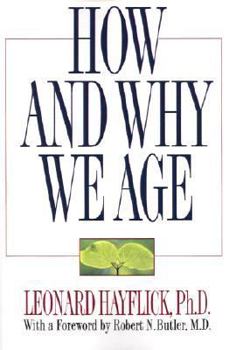How and Why We Age
Select Format
Select Condition 
Book Overview
Preeminent cell biologist Leonard Hayflick reveals the results of more than thirty years of pioneering research in the field of aging. Gracefully written, clearly organized, and packed with essential... This description may be from another edition of this product.
Format:Paperback
Language:English
ISBN:0345401557
ISBN13:9780345401557
Release Date:January 1996
Publisher:Ballantine Books
Length:377 Pages
Weight:1.15 lbs.
Dimensions:0.9" x 5.5" x 8.2"
Customer Reviews
4 ratings
Old Book but Packed with Relevant Thoughts
Published by RadioFan , 3 years ago
This is worth reading cover-to-cover. It is published perhaps in 1994 but presents very relevant information even for current times. The author covers a lot of ground in explaining the phenomenon and discussing the social and scientific aspects.
Excellent service
Published by Thriftbooks.com User , 14 years ago
Book was delivered quickly and in exactly the condition it was described. I would do business with the sellers again.
A Mature Approach
Published by Thriftbooks.com User , 17 years ago
This is the best book on aging I've read. In a lucid, even-handed style, Hayflick discusses the scientific discoveries that have been made about the aging process, and presents the evidence behind a variety of different theories of aging. This sort of unbiased approach is rare in books on the subject. So many books on aging turn out to be mere commercials for some vitamin regimen or some rejuvenation scheme. But Hayflick isn't selling any lotions, potions, or contraptions - so on most scores, he can be trusted to be more objective. Hayflick himself is famous for having contributed to discovering that the progressive shortening of the ends of our chromosomes (the telomeres) is associated with cellular aging. However, he doesn't advance telomere research as an exclusive gateway to understanding the aging process. He gives equal time to other theories of aging, such as the theory that it's a simple matter of wear-and-tear. Hayflick even goes back to basics and discusses whether or not we actually are living longer than our ancestors, or whether we just seem to be because of a decline in infant mortality. He also offers clues to aging from the varying life-spans of other species. He presents a number of telling but rather depressing findings that tend to confirm the theory recently advanced by a number of authors - that our bodies are designed to repair errors and malfunctions only long enough to allow us to reproduce. After that, we are dispensable and so no further time and energy is wasted on our up-keep. We coast downhill into old age. Hayflick continues with some telling facts about cancer that I hadn't heard before. He points out that the incidence of cancer peaks during people's sixties, then declines. Also, autopsies reveal that one-half of all their subjects have cancer when they die, although cancer wasn't what killed them. Then there are good pages on the immune system and the fact that early exposure to various antigens produces more effective immunity against those foreign bodies and possibly a heightened resistance to cancer. I was reminded here though of the opposite opinion held by Gerald Dermer, author of "The Immortal Cell." Dermer suggested that the key to fighting cancer was to weaken the immune system in order to allow various viruses to attack. It's in the nature of most viruses to specifically invade and kill rapidly dividing cells, which defines most cancer cells. When some cancer patients contracted mumps, their cancers were eradicated. This all goes to show that there still is no consensus about what causes aging, or about how to combat some of the diseases that strike people down before they can become jolly centenarians. So you might not live longer as a result of reading this book. But you will garner some lively, possibly fruitful information. And you might save money. You might find yourself being convinced that expensive regimens of supplements and exotic lifestyle changes have been shown to contribute little or
A first-hand account on research on the biology of aging
Published by Thriftbooks.com User , 25 years ago
Hayflick's book "How and Why We Age" is an excellent, first hand account on the research that has been conducted up to now on the biology of aging. It is of note that Hayflick is one of the pioneers in the field. The book is well written and can be enjoyed both by the scientist and the layperson. One flaw, in my opinion, involves Hayflick's personal- and highly biassed- account of the supposedly erroneous conclusions of Alexis Carrel regarding the immortality of cells cultured in vitro. After presenting what seems conclusive evidence opposing Carrel's claim, Hayflick describes a conversation with a technician who worked at Carrel's lab in New York in the thirties, who discloses highly questionable procedures, and describes threats to her when she reaised issues with the lab directors. It is clearly suggested that there was scientific negligence and even misconduct, and yet, the identity of this technician is not revealed, and the accusations, half a century la! ter, are foggy and impossible to challenge. This is a very serious issue, as Hayflick himself claims to have proven Carrel wrong, through his discovery of a fixed maximum number of divisions in cells grown in vitro. However, some even more recent experiments suggest that it is Hayflick who is wrong, because the cell culture conditions he uses are highly artificial, while Carrel's more primitive, but also more robust method (cultivating a chunk of tissue) are closer to physiological conditions. The issue at stakes is by no means trivial: are cells intrinsically immortal, ageless, or do they age and die like whole organisms?





